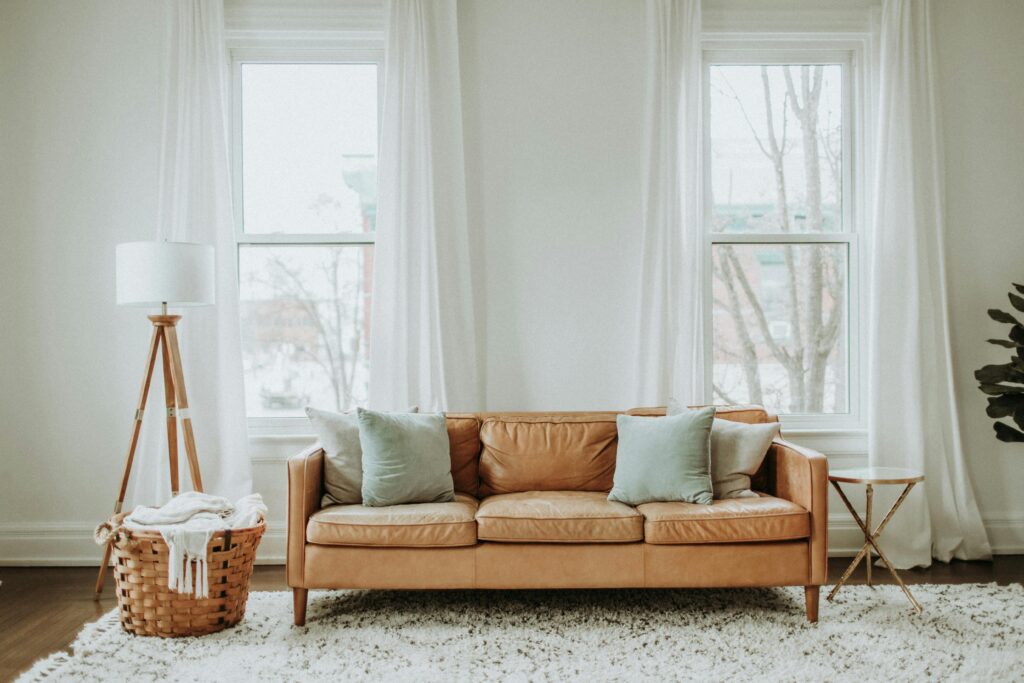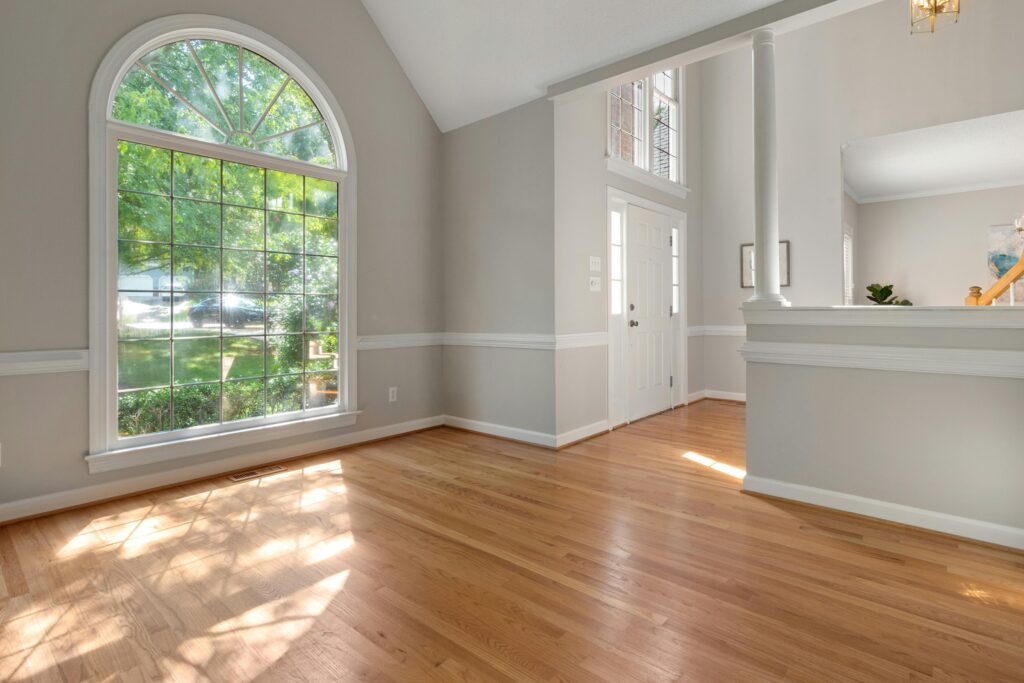In this article, we’ll dive deep into the world of materials and finishes ideal for your windows, helping you navigate the choices that balance durability, aesthetics, and performance. Whether you’re renovating an old home or building a new one, understanding the pros and cons of different window materials like vinyl, wood, aluminum, and fiberglass is essential. Equally important is selecting finishes that complement your architectural style while offering protection against weather and wear.
Table of Contents
ToggleKey Takeaways
- Balance Durability, Aesthetics & Performance: Select window materials that not only look good but also withstand daily wear and climatic challenges.
- Compare Core Materials: Understand the pros and cons of vinyl, wood, aluminum, and fiberglass to match your project needs.
- Match Finishes to Style: Choose paint, powder coat, stain or laminate finishes that complement your home’s architectural design.
- Ensure Weather Protection: Opt for coatings and treatments that guard against moisture, UV exposure, and temperature extremes.
- Plan for Maintenance: Factor in upkeep requirements—some materials and finishes need more care to retain their appearance and function.
- Consider Long-Term Value: Investing in quality materials and protective finishes can improve energy efficiency and boost property resale value.
Why Choosing the Right Materials and Finishes for Your Windows Matters More Than You Think
When it comes to enhancing your home’s comfort, aesthetics, and energy efficiency, the choice of materials and finishes for your windows plays a crucial role. Windows are not just openings for light and air; they are pivotal elements that influence your home’s overall performance and style. Understanding the importance of selecting the ideal window materials and finishes can dramatically impact your living environment, your energy bills, and even your property value.
What Are Materials and Finishes for Windows?
Materials refer to the core substances used to manufacture window frames and sashes, common options include wood, vinyl, aluminum, fiberglass, and composite blends. Finishes describe the surface coating or treatment applied to these materials, such as paint, stains, powder coating, or laminates, which protect the window from weather elements and dictate its visual appeal.
Choosing the right materials and finishes for your windows means balancing durability, maintenance, cost, and appearance. For example, wooden windows offer timeless beauty and insulation but require more upkeep, while vinyl is low maintenance and affordable but may lack the premium look of natural wood.
The Significance Backed by Data
Statistics from the U.S. Department of Energy reveal that windows can account for up to 30% of residential heating and cooling energy losses. By opting for superior materials and appropriate finishes, homeowners can reduce these losses significantly. For instance, fiberglass frames perform exceptionally well in resisting temperature fluctuations, resulting in better insulation, while certain finishes can enhance UV resistance to preserve window longevity.
Moreover, a report published by the National Association of Home Builders indicates that upgrading windows with energy-efficient materials can recoup approximately 70-80% of the investment cost at resale. This demonstrates that the right choice not only benefits current energy savings but adds tangible value to your property.
Real-Life Success Story: The Smith Family Renovation
Take the experience of the Smith family from Denver, Colorado, who recently renovated their 1980s home. Faced with drafty windows and skyrocketing energy bills, they decided to replace their old aluminum-framed windows with fiberglass frames finished with a custom powder coat paint that complemented their home’s modern aesthetic.
Post-installation, the Smiths witnessed a 25% reduction in their heating costs during winter. Furthermore, their home’s indoor temperature remained consistent, and the windows required minimal maintenance despite the harsh Colorado weather. This change not only improved their comfort but also increased their home’s curb appeal, making their property more attractive when they later chose to sell.
Why It Should Matter to You
Understanding the integral role of materials and finishes for your windows empowers you to make informed decisions, ensuring that your investment yields long-term benefits. Whether you aim to enhance your home’s energy efficiency, reduce maintenance time, or uplift its style, the right window components are foundational.
In the upcoming sections, we’ll explore diverse window materials and finishes in depth, helping you identify the perfect combination tailored to your lifestyle, budget, and design preferences. Remember, windows are more than just glass, they are strategic components that protect, beautify, and improve your living space. Choosing wisely today means appreciating the rewards for years to come.
How to Choose the Ideal Materials and Finishes for Your Windows Step by Step
Selecting the right materials and finishes for your windows can transform your home’s appearance, enhance energy efficiency, and increase durability. But with so many options on the market, it’s easy to feel overwhelmed. This guide will walk you through the process of choosing the perfect materials and finishes for your windows, ensuring you make an informed decision that suits your style and needs. Let’s dive into a step-by-step approach that balances aesthetics, function, and budget.
Step 1: Assess Your Needs and Environment
Before diving into different options, understand the specific needs of your windows based on your home’s location and usage:
– Climate considerations: Are you in a hot, cold, humid, or windy area? Different materials perform better under certain weather conditions.
– Usage frequency: Windows in high-traffic areas may require more durable finishes.
– Maintenance preferences: Do you want low-maintenance windows, or are you willing to do regular upkeep?
– Security needs: Some materials offer better resistance to break-ins.
Taking time to evaluate these factors helps narrow choices and ensures that your final decision aligns with your lifestyle and environment.
Step 2: Understand the Most Popular Window Materials
Different materials offer unique advantages and considerations. Here are the key options with their main pros and cons:
– Wood
– Pros: Classic look, excellent insulation, customizable with paint or stain.
– Cons: Requires regular maintenance, prone to rot and warping if not treated well.
– Vinyl
– Pros: Affordable, low maintenance, energy-efficient, resists moisture.
– Cons: Limited color options, may warp under extreme temperatures.
– Aluminum
– Pros: Strong and lightweight, slim frames for more glass area, modern aesthetics.
– Cons: Poor insulator unless thermally broken, can corrode in coastal areas.
– Fiberglass
– Pros: Extremely durable, low maintenance, excellent insulation, can mimic wood.
– Cons: Higher upfront cost.
By comparing these materials, you can align their properties with what you prioritized in Step 1.
Step 3: Choose the Appropriate Finish for Each Material
Finishes protect your window frames and add style. Here’s how to select finishes depending on the material:
– For Wood Windows:
– Paint: Offers vibrant color options and helps protect against moisture.
– Stain: Highlights natural wood grain with a more organic look.
– Varnish or Sealant: Adds a protective layer that preserves wood texture.
– For Vinyl Windows:
– Typically comes pre-finished in neutral colors like white, beige, or brown.
– Custom coatings: Available through certain manufacturers for unique colors and textures.
– For Aluminum Windows:
– Anodized finish: Enhances corrosion resistance and adds a metallic sheen.
– Powder coating: Durable color finish available in many shades, excellent against scratches.
– For Fiberglass Windows:
– Usually available in factory-applied paint in a wide range of colors.
– Can be refinished later with special primers and paints.
Pay attention to the durability and maintenance required for each finish, as this directly affects the longevity and appearance of your windows.
Step 4: Consider Energy Efficiency Ratings and Certifications
The ideal materials and finishes for your windows should contribute to energy efficiency. Look for:
– ENERGY STAR® certification: Indicates windows meet high energy-saving standards.
– U-Factor rating: Measures heat retention; lower values mean better insulation.
– Solar Heat Gain Coefficient (SHGC): Indicates solar heat admitted; lower means less heat gain.
Certain materials like fiberglass and wood tend to have better insulative properties, but finishes also matter , reflective coatings or specialty paints can significantly impact window performance.
Step 5: Factor in Style and Design
Your windows are a key architectural element. Balancing materials and finishes to match your home’s style is essential:
– Modern homes: Sleek aluminum or fiberglass frames with minimalist finishes.
– Traditional homes: Warm wood with stained finishes or painted wood with classic colors.
– Coastal properties: Durable vinyl or aluminum with corrosion-resistant finishes.
Envision how the material and finish will complement your exterior and interior décor.
Step 6: Budget and Long-Term Cost Analysis
Initial price is important, but also consider:
– Maintenance expenses: Wood requires more upkeep than vinyl or fiberglass.
– Longevity: Durable materials and finishes can reduce replacement frequency.
– Energy savings: Efficient materials can lower heating and cooling bills over time.
Weigh your budget against performance and maintenance to find an optimal balance.
Step 7: Consult with Professionals and Review Samples
Before finalizing:
– Talk to window installers or manufacturers for recommendations specific to your home.
– Request material and finish samples to visualize textures and colors firsthand.
– Review warranties and maintenance instructions.
This final step ensures confidence in your choices and prevents costly mistakes.
Example: Applying the Steps to a Real Case
Imagine you live in a humid, coastal region and want durable, low-maintenance windows with a clean modern look:
– Step 1: Prioritize moisture resistance and corrosion protection.
– Step 2: Vinyl or aluminum frames are ideal.
– Step 3: Choose powder-coated aluminum for extra durability or white vinyl for low maintenance.
– Step 4: Check ENERGY STAR® certification for enhanced insulation.
– Step 5: Opt for minimalistic slim frames to complement your home’s architecture.
– Step 6: Compare costs and long-term benefits; vinyl tends to be more affordable upfront.
– Step 7: Consult a local installer and order samples before committing.
By following this step-by-step guide, anyone can confidently decide on the best materials and finishes for their windows, balancing beauty, function, and budget perfectly.
Choosing the right materials and finishes for your windows might seem daunting at first, but following these steps brings clarity and confidence. Remember, the perfect window transforms not just your house, but your everyday living experience.

Tips for Choosing the Perfect Materials and Finishes for Your Windows:
✅ Opt for Wood Frames: Wood offers excellent insulation and a timeless look, perfect for traditional and cozy settings.
❄️ Choose Vinyl for Energy Efficiency: Vinyl frames are low-maintenance and provide great thermal performance, ideal for reducing energy bills.
🌳 Consider Aluminum for Modern Appeal: Aluminum is durable, lightweight, and perfect for sleek, contemporary window designs.
💧 Use Weather-Resistant Finishes: Select paints or coatings that protect against moisture, ensuring longevity in humid or rainy climates.
🔧 Prioritize Easy Maintenance: Materials like fiberglass and vinyl require less upkeep, saving time and effort over the years.
🎨 Match Finishes to Interior Style: Coordinate window finishes with your room décor to create a harmonious and inviting atmosphere.
🌞 Invest in UV-Resistant Coatings: Protect your window frames and interiors from sun damage and fading with UV-blocking finishes.
♻️ Choose Sustainable Materials: Eco-friendly options like reclaimed wood or recycled aluminum help reduce environmental impact while maintaining beauty.
Key Concepts
When diving into the world of windows, understanding the materials and finishes that compose these essential elements of a building is like unlocking the secrets to both function and style. Windows are not mere openings; they are gateways that connect the interior with the outside world, balancing light, air, security, and aesthetic appeal. To truly appreciate the impact of choosing the right materials and finishes, one must explore the foundational concepts that define their performance and character.
The Material Essence: More Than Just A Frame
Materials used in window construction transcend the role of simple structural supports; they are the silent heroes influencing efficiency, durability, and design language. Think of window materials as the skin of a living organism, they must shield against environmental stressors while allowing the ‘breath’ of the home to flow.
– Wood: Wood is the poetic choice, warm, natural, and classic. Its charm lies in its organic texture and ability to be intricately crafted. However, wood is alive in a way; it ‘breathes’ humidity and must be cared for to prevent decay. Imagine wood as the soulful artist in the symphony of window materials, adding character and a timeless narrative.
– Aluminum: If wood is the artist, aluminum is the engineer: sleek, strong, and modern. It withstands harsh conditions, bending minimally to the pressures of wind or weather. This material carries the story of innovation and industrial progress, offering slim frames that do not sacrifice structural integrity.
– Vinyl: Vinyl embodies pragmatism. It is the efficient worker, cost-effective and low maintenance, yet flexible enough to mimic other textures and finishes. Its plastic essence offers a barrier against moisture and air infiltration, acting somewhat like a shield that guards the internal environment with quiet reliability.
– Fiberglass: Fiberglass is the chameleon of window materials, melding strength and versatility. It bears the resilience of manufactured composites while adapting successfully to a variety of climates, maintaining stability where other materials might falter. Picture fiberglass as the adaptable protagonist, balancing performance and subtlety.
Finishes: The Final Flourish with Purpose
Beyond the core material lies the realm of finishes , the artful covering that defines the window’s final look, texture, and longevity. Finishes are the storytellers, the last brushstroke that determines how windows will resonate visually and withstand time’s erosion.
– Paints and Stains: These are the colorists, adding personality and mood to wood windows in particular. Stains reveal the grain, preserving the natural tale of wood, while paints can transform it completely, allowing for any color vision. They are not merely decoration but protective layers that slow the narrative of deterioration.
– Anodizing and Powder Coating: Mostly applied to aluminum, these finishes act as armor and embellishment combined. Anodizing chemically bonds a layer of oxide, making it tougher and often metallic in sheen. Powder coating, on the other hand, is like clothing tailored to resist chips, scratches, and fading, offering a palette of endless hues.
– Laminates and Foils: Often used to cover vinyl or wood, laminates and foils introduce texture and mimicry, like costume designers crafting outfits that elevate the ordinary to the extraordinary. These can imitate the richness of wood grain or provide solid colors, marrying aesthetics with practicality.
The Concept of Thermal Performance as Material Dialogue
One core conceptual understanding lies in how materials and finishes influence thermal performance, a dialogue between inside and outside environments. Windows are borders where heat can be lost or gained, and every material has its voice in this conversation.
Wood naturally insulates, reducing conductivity like a cozy sweater against cold winds. Aluminum, the opposite, is a conductor, often requiring thermal breaks, a sort of wall within the wall, to interrupt heat flow. Vinyl and fiberglass aim for a middle ground, combining low conductivity with structural strength. Finishes further influence this narrative by sealing pores, reflecting sunlight, or absorbing heat, thus becoming active participants in energy efficiency.
Durability and Maintenance: The Temporal Layer
Understanding window materials also requires a grasp of their lifecycle, a temporal dimension that governs how these choices endure or fade. Some materials tell stories of resilience; others speak of vulnerability.
Wood’s narrative demands care and renewal, it ages like a classic novel, gaining beauty but also showing wear. Aluminum writes a modern epic of endurance, resisting rust and warping with ease. Vinyl and fiberglass are pragmatic tales of minimal maintenance, designed to weather years without needing drastic intervention.
Finishes, meanwhile, often mark the passage of time, paint may peel and require rewriting, powder coats may dull but rarely fail. This dynamic interplay of material and finish sets the stage for the window’s lifelong dialogue with environment and occupant.
Aesthetic Harmony: Crafting with Context
Finally, the choice of materials and finishes is deeply entwined with the concept of harmony, how windows narrate the story of a building’s design and its cultural context. They are like actors on the architectural stage, playing roles that range from subtle background to commanding presence.
Traditional homes often call for wood’s warm embrace, where hand-applied stains evoke heritage. Urban lofts might favor aluminum’s sleek minimalism, projecting a story of contemporary life and technological confidence. Suburban homes might blend vinyl’s versatility with laminate finishes, aiming for practical beauty and cost-consciousness.
In essence, materials and finishes are the language through which windows speak, each choice a word contributing to the dialogue between form, function, and environment.
By exploring these key concepts, the intrinsic nature of materials, the art and science behind finishes, and their dialogues with thermal performance, durability, and aesthetics, one can appreciate that selecting the ideal combination for windows is an intricate tale. It’s where science meets poetry, structure meets style, and every choice shapes the environment we live in and the stories our homes tell.
Frequently Asked Questions about Ideal Materials and Finishes for Your Windows
❓ What are the most durable materials for window frames?
The most durable materials for window frames include vinyl, fiberglass, and aluminum. Vinyl is popular for its resistance to moisture and low maintenance, while fiberglass offers excellent strength and energy efficiency. Aluminum frames are sturdy and sleek but may require thermal breaks to improve insulation.
❓ Which finishes are best for windows exposed to harsh weather?
For windows exposed to harsh weather, finishes like powder coating or anodizing are ideal. These finishes protect metal frames from corrosion and fading caused by UV rays, rain, and snow. Additionally, high-quality paint finishes on wood frames can help seal and protect the material.
❓ Are wood window frames still recommended for modern homes?
Yes, wood window frames remain a popular choice for modern homes due to their aesthetic appeal and natural insulation properties. However, they do require more maintenance, including regular sealing or painting, to protect against moisture and insects.
❓ How do materials and finishes impact window energy efficiency?
Materials like fiberglass and vinyl with insulated glass and energy-efficient finishes can significantly reduce heat loss and gain. Proper finishes help prevent air and moisture infiltration, enhancing your home’s comfort and reducing energy bills.
❓ Can I mix different materials and finishes for my windows?
Absolutely! Combining materials, such as wood interiors with aluminum or vinyl exteriors, offers both beauty and durability. Different finishes on each side can protect the window from weather while matching your interior design.


